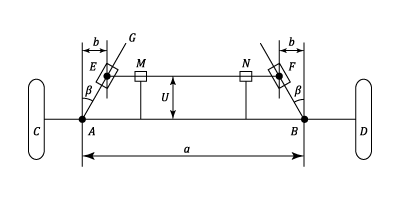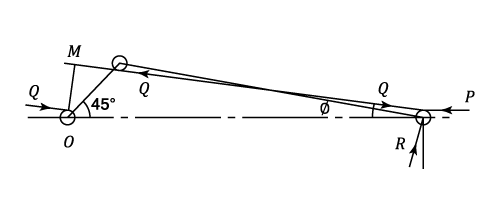Mechanisms
Introduction
This submission, the first in a number planned for "The Theory of Machines" introduces Forces in Mechanisms, including The Friction Circle and The concept of Instantaneous Centres and velocities within a Mechanism. An analysis of Hooke's Universal Coupling is given. In addition a number of worked examples are included to illustrate the theory.MISSING IMAGE!
23287/Mechanisms-hook1.png cannot be found in /users/23287/Mechanisms-hook1.png. Please contact the submission author.
A kinematic Pair represents two bodies which are in contact and there is relative motion between them. If the motion is one of sliding between surfaces in contact ( e.g. cross-heads in guides, Shafts in bearings, A screw and nut), it is known as A lower Pair. When the contact takes place along a line ( e.g. a Cam and follower or toothed gearing) it is called A higher pair.
A kinematic Chain is a combination of Kinematic Pairs which have been so joined together that the relative motion between the Elements is completely determined.
A Mechanism is obtained if one link of a Kinematic Link is fixed. Differing Mechanisms may be obtained by fixing different elements of the same chain. These are called inversions . For example The slider-crank chain (Engine Mechanism) becomes an oscillating-cylinder mechanism if the original "connecting-rod" is fixed, or a Whitworth "Quick-return mechanism" if the crank becomes the fixed link.
Instantaneous Centre
- Where two links in a mechanism are pinned together, the pin-joint becomes the relative instantaneous centre.
- Where two bodies are in pure rolling contact, the point of contact is the relative instantaneous centre.
- It will be shown that the three instantaneous centres due to the relative motion of any three elements in a mechanism are in a straight line.
MISSING IMAGE!
23287/Mechanisms-m1-0010.png cannot be found in /users/23287/Mechanisms-m1-0010.png. Please contact the submission author.
Velocity And Acceleration
Apart from the use of Instantaneous Centres, velocity can also be determined by differentiating the angular or linear displacement of a point. Acceleration can of course be found from the second differentiation.Angular Displacement, Velocity And Acceleration
Let,- The line
in the diagram rotate around
- Its inclination relative to
be
radians.
MISSING IMAGE!
23287/Gyroscopes-0001-12.png cannot be found in /users/23287/Gyroscopes-0001-12.png. Please contact the submission author.
- If after a short period of time the line has moved to lie along
, then the angle
is The Angular Displacement of the line.
Angular Displacement
- Angular Displacement is a vector quantity since it has both magnitude and direction. The vector must fix:In order to fix the vector, it can be drawn at right angles to the plane in which the angular displacement takes place. Say this is along the axis of rotation and its length is, to a convenient scale,the magnitude of the displacement. The conventional way of representing the sense of the vector , is to use the right-hand screw rule. i.e.,
- The direction of the axis of rotation in space.
- The sense of the angular displacement. i.e. whether clockwise or anti-clockwise.
- The magnitude of the angular displacement.
- The arrow head points along the vector in the same direction as a right handed screw would move, relative to a fixed nut.
- Using the above convention, the angular displacement
shown in the diagram would be represented by a vector perpendicular to the plane of the screen and the arrow head would point away from the screen.
Angular Velocity
- This is defined as the rate of change of angular displacement with respect to time. As angular velocity has both magnitude and direction it is a vector quantity and may be represented in the same way as angular displacement.If the direction of the angular displacement vector is constant. i.e., the plane of the angular displacement does not change its direction, then the angular velocity is merely the change in magnitude of the angular displacement with respect to time.
Angular Acceleration
- It is defined as the rate of change of angular velocity with respect to time. It is a vector quantity. The direction of the acceleration vector is not necessarily the same as the displacement and velocity vectors.Assume that a given instant a disc is spinning with an angular velocity of
in a plane at right angles to the screen and that after a short interval of
its speed has increased to
.
MISSING IMAGE!
23287/Gyroscopes-0002.png cannot be found in /users/23287/Gyroscopes-0002.png. Please contact the submission author.
The angular acceleration
- The component parallel to
is given by
- The component perpendicular to
is given by
is the rate of change of direction of the vector
is the rate of change of the magnitude of the velocity
of the disc.
is the rate at which the direction of
and therefore the plane of the rotation of the disc is changing.
- The total angular acceleration of the disc is the vector sum of
and
- If the plane of rotation of the disc is constant in direction, then
is zero and the component of acceleration
is zero.
- If the angular acceleration of the disc is constant in magnitude but the plane of rotation changes direction at the rate
radians per second, then the angular acceleration of the disc is given by:
Forces In Mechanisms.
The forces acting on the individual links of a mechanism can be analysed using the laws of Statics. Inertia forced must either be neglected or allowed for by using the methods shown under Inertia Forces and Couples. Each link is in equilibrium under the action of the external forces acting on it and the reactions at points of contact with other links. The following principles apply:- Action and reaction between two bodies must be equal and opposite.
- If a body is acted upon by forces at two points only then these forces must be not only equal and opposite but in the same line. e.g. the reactions at each end of a link connected by single pin joints to adjoining links and not acted upon by any external forces must be equal and in the direction of the line between the pin joints.
- If a body is acted upon by three forces only then these must pass through a common point
- In general for a body in plane motion, three conditions of equilibrium can be obtained by resolving and or taking moments.
Friction
Smooth surfaces are defined by the properties that when they are in contact, the surface is always perpendicular to their common tangent plane.- Law 1 When two bodies are in contact the direction of the forces of Friction on one of them at it's point of contact, is opposite to the direction in which the point of contact tends to move relative to the other.
- Law 2 If the bodies are in equilibrium, the force of Friction is just sufficient to prevent friction and may therefore be determined by applying the conditions of equilibrium of all the forces acting on the body.
- Law 3 The ratio of the limiting friction to the Normal reaction between two surfaces depends on the substances of which the surfaces are composed and not on the magnitude of the Normal reaction. This ratio is usually denoted by
Thus, if the Normal reaction is
, the limiting friction is
For given materials polished to the same standard
is found to be constant and independent of
.
is called the coefficient of friction.
- Law 4 The amount of limiting friction is independent of the area of contact between the two surfaces and of the shape of the surfaces, provided that the Normal reaction is unaltered.
- Law 5 When motion takes place the direction of friction is opposite to the direction of relative motion and independent of velocity. The magnitude of the force of friction is in a constant ratio to the Normal reaction but this ratio may be slightly less than when the body is just on the point of moving.
Angle Of Friction
MISSING IMAGE!
23287/Mechanisms-tri-of-friction.png cannot be found in /users/23287/Mechanisms-tri-of-friction.png. Please contact the submission author.
MISSING IMAGE!
23287/Mechanisms-cone-of-friction.png cannot be found in /users/23287/Mechanisms-cone-of-friction.png. Please contact the submission author.
The Friction Circle And Friction Axis
For a turning pair ( Shaft and Journal or Pin and Bearing) it is assumed that contact is along the axial line and that the total reaction will pass through the position of contact. Diagram (a) shows the forces when the shaft is at rest. It is assumed that there is no friction and the only two forces areExample - Example 1


Hooke's Universal Coupling
The diagrams show a Hook's joint in which shaftMISSING IMAGE!
23287/Mechanisms-hook1.png cannot be found in /users/23287/Mechanisms-hook1.png. Please contact the submission author.
MISSING IMAGE!
23287/Mechanisms-hook3.png cannot be found in /users/23287/Mechanisms-hook3.png. Please contact the submission author.
Example - Example 1
- The weight must be
Double Hooke's Joint
MISSING IMAGE!
23287/Mechanisms-hook4.png cannot be found in /users/23287/Mechanisms-hook4.png. Please contact the submission author.
Example - Example 1

- The Turning Moment on the Crankshaft =
 Login
Login

